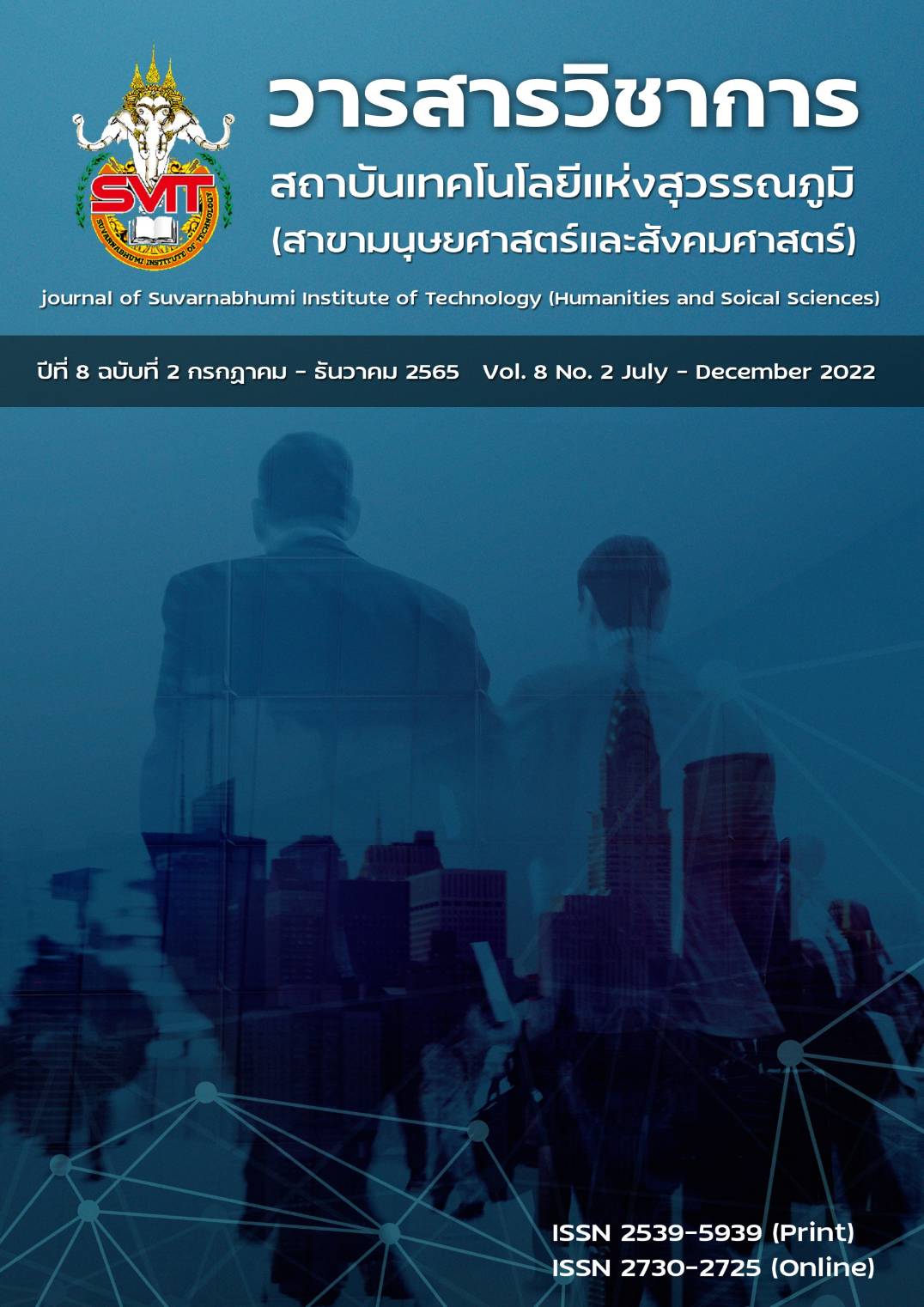THE PLANNING FOR THAI CULTURE SACRED OBJECT SHOP FOR ASEAN AND CHINESE TOURISTS IN PATTAYA CITY, THAILAND
Keywords:
Amulet, Talisman, travel, Thai CultureAbstract
The purpose of this research is to study belief and faith in the sacred objects of Asean and Chinese tourists to study the marketing plan action plan Strategic plan for sacred object shop to study the market feasibility for sacred object shop from Asean and Chinese tourists in Pattaya, Thailand. This research is qualitative research by in-depth interview. In analyzing and summarizing the results to study the market feasibility for sacred object shops according to Thai culture from the group of Asean and Chinese tourists in Pattaya, Thailand. The sample group in the research was 11 Asean tourists, divided into 3 Singaporeans, 3 Malaysians and 5 Chinese nationals, 5 sacred object shop owners, 1 sacred object specialist.
The results of the research found that belief and faith, marketing plans, operational plans Strategic Plans, and Marketing Feasibility As for the sacred object shop it is divided into 4 areas, consisting of form aspects, which are divided into modernity, fashion, and beauty. In terms of construction, it is divided into reliability. Master builders and Buddhist monks whose distinctive characteristics are great charm fortune and protection. Customer groups are divided into Chinese Asean and Thai people. Which have 2 groups, consisting of working age groups and teenagers. The place of sale is divided into online formats, namely line Taobao, Instagram, Facebook, and product warranty. Storefront style is decorating the store to look credible. There is a clear selling point and a guarantee for the product.
References
คริษฐา เกยด่านกลาง (2563). กลยุทธ์ทางการตลาดเพื่อเพิ่มยอดเช่าบูชา พระเครื่องพระบูชาหลวงพ่อพระใสวัดอารามหลวง วัดโพธิ์ชัย จังหวัดหนองคาย. วารสารวิชาการและวิจัย มหาวิทยาลัยภาคตะวันออกเฉียงเหนือ, 10(1), 73-87.
จุฑาทิพย์ ทิพย์เหรียญ. (2559). พฤติกรรมการซื้อของฝากของนักท่องเที่ยวชาวจีนแบบอิสระ ในเขตกรุงเทพมหานคร. (การค้นคว้าอิสระปริญญามหาบัณฑิต, มหาวิทยาลัยธรรมศาสตร์).
ชัยภักดิ์ อรัญญภูมิ (2560). ปัจจัยส่วนประสมทางการตลาดที่มีต่อการตัดสินใจเช่าพระเครื่องในตลาดทิพย์เนตรอำเภอเมือง จังหวัดเชียงใหม่. (รายงานการค้นคว้าอิสระปริญญามหาบัณฑิต, มหาวิทยาลัยแม่โจ้).
ณัฐพงศ์ ดวงแก้ว. (2562). ครูบาคติใหม่ : แต่งองค์ทรงเครื่อง พุทธศรัทธาหลังกึ่งพุทธกาล. กรุงเทพฯ: มติชน.
ถวัลรัตน์ กัลชาญกิจ และ ธาตรี ใต้ฟ้าพูล. (2558). บุคลิกภาพผู้บริโภค ความเชื่อโชคลางและพฤติกรรม การซื้อเครื่องประดับหินสีมงคล. เข้าถึงได้จาก http://cuir.car.chula.ac.th/handle/123456789/51089
ยุพารักษ์ ชนะบวรวัฒน์. (2560). การบนสิ่งศักดิ์สิทธิ์ของชาวพุทธในสังคมไทย. วิทยานิพนธ์ปริญญามหาบัณฑิต, มหาวิทยาลัยธรรมศาสตร์.
ศิริวรรณ เสรีรัตน์และคณะ, (2546) พฤติกรรมผู้บริโภค.กรุงเทพฯ: วิสิทธ์วัฒนา.
อภินันท์ จันตะนี. (2559). เศรษฐกิจพระเครื่องเมืองไทย. วารสารบัณฑิตศึกษา มหาวิทยาลัยราชภัฏวไลยอลงกรณ์ ในพระบรมราชูปถัมภ์, 10(1).
อธิราชย์ นันขันตี. (2558). การนับถือผีของชาวไทยย้อ: ความสัมพันธ์ด้านความเชื่อและนิเวศวิทยาปรัชญา พุฒิวัฒนธรรม. (วิทยานิพนธ์ปรัชญาดุษฎีบัณฑิต, มหาวิทยาลัยบูรพา)
Belk, W., R., Gulnur, & Tumbat. (2005). The Cult of Macintosh. Consumption Markets and Culture, 205-218.
Diego, Stefania, Gary, & Robert. (2012). When Sacred Objects Go B®a(n)d: Fashion Rosaries
and the Contemporary Linkage of Religion and Commerciality, in Rinallo, Diego and Linda M. Scott, ed., Spiritual and Sacred Consumption, London: Routledge, 29-40.Retrieved from https://www.researchgate.net/publication/285085757_
When_sacred_objects_go_brand_fashion_rosaries_and_the_contemporary_linkage_of_religion_and_commerciality
Diego, R., & Mathieu, A.O. (2018). The marketing and consumption of spirituality and religion. Journal of Management, Spirituality & Religion. Retrieved from https://doi.org/ 10.1080/14766086.2019.1555885
Muniz, A.O.T., & Schau, H. J. (2005). Religiosity in the Abandoned Apple Newton Brand Community. Customer Research, 737-747.
Spiggle, S. (1986). Measuring Sooial Values: A Content Analysis of Sunday Comics and Underground Comix. Journal of Consumer Research, 13 (June), 100-113.
Downloads
Published
Issue
Section
License
Copyright (c) 2022 Suvarnabhumi Institute of Technology

This work is licensed under a Creative Commons Attribution-NonCommercial-NoDerivatives 4.0 International License.
บทความที่ได้รับการตีพิมพ์เป็นลิขสิทธิ์ของวารสารวิชาการ สถาบันเทคโนโลยีแห่งสุวรรณภูมิ
ข้อความที่ปรากฏในบทความแต่ละเรื่องในวารสารวิชาการเล่มนี้เป็นความคิดเห็นส่วนตัวของผู้เขียนแต่ละท่านไม่เกี่ยวข้องกับสถาบันเทคโนโลยีแห่งสุวรรณภูมิ และคณาจารย์ท่านอื่นๆในสถาบันฯ แต่อย่างใด ความรับผิดชอบองค์ประกอบทั้งหมดของบทความแต่ละเรื่องเป็นของผู้เขียนแต่ละท่าน หากมีความผิดพลาดใดๆ ผู้เขียนแต่ละท่านจะรับผิดชอบบทความของตนเองแต่ผู้เดียว





